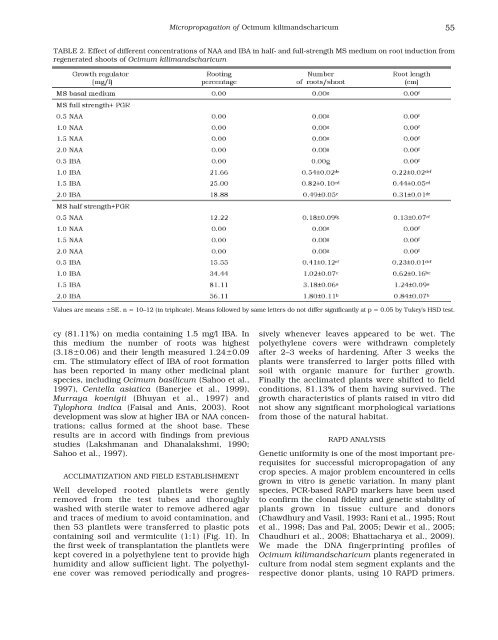MICROPROPAGATION OF OCIMUM KILIMANDSCHARICUM ...
MICROPROPAGATION OF OCIMUM KILIMANDSCHARICUM ...
MICROPROPAGATION OF OCIMUM KILIMANDSCHARICUM ...
You also want an ePaper? Increase the reach of your titles
YUMPU automatically turns print PDFs into web optimized ePapers that Google loves.
cy (81.11%) on media containing 1.5 mg/l IBA. In<br />
this medium the number of roots was highest<br />
(3.18±0.06) and their length measured 1.24±0.09<br />
cm. The stimulatory effect of IBA of root formation<br />
has been reported in many other medicinal plant<br />
species, including Ocimum basilicum (Sahoo et al.,<br />
1997), Centella asiatica (Banerjee et al., 1999),<br />
Murraya koenigii (Bhuyan et al., 1997) and<br />
Tylophora indica (Faisal and Anis, 2003). Root<br />
development was slow at higher IBA or NAA concentrations;<br />
callus formed at the shoot base. These<br />
results are in accord with findings from previous<br />
studies (Lakshmanan and Dhanalakshmi, 1990;<br />
Sahoo et al., 1997).<br />
ACCLIMATIZATION AND FIELD ESTABLISHMENT<br />
Well developed rooted plantlets were gently<br />
removed from the test tubes and thoroughly<br />
washed with sterile water to remove adhered agar<br />
and traces of medium to avoid contamination, and<br />
then 53 plantlets were transferred to plastic pots<br />
containing soil and vermiculite (1:1) (Fig. 1f). In<br />
the first week of transplantation the plantlets were<br />
kept covered in a polyethylene tent to provide high<br />
humidity and allow sufficient light. The polyethylene<br />
cover was removed periodically and progres-<br />
Micropropagation of Ocimum kilimandscharicum 55<br />
TABLE 2. Effect of different concentrations of NAA and IBA in half- and full-strength MS medium on root induction from<br />
regenerated shoots of Ocimum kilimandscharicum<br />
Values are means ±SE. n = 10–12 (in triplicate). Means followed by same letters do not differ significantly at p = 0.05 by Tukey's HSD test.<br />
sively whenever leaves appeared to be wet. The<br />
polyethylene covers were withdrawn completely<br />
after 2–3 weeks of hardening. After 3 weeks the<br />
plants were transferred to larger potts filled with<br />
soil with organic manure for further growth.<br />
Finally the acclimated plants were shifted to field<br />
conditions, 81.13% of them having survived. The<br />
growth characteristics of plants raised in vitro did<br />
not show any significant morphological variations<br />
from those of the natural habitat.<br />
RAPD ANALYSIS<br />
Genetic uniformity is one of the most important prerequisites<br />
for successful micropropagation of any<br />
crop species. A major problem encountered in cells<br />
grown in vitro is genetic variation. In many plant<br />
species, PCR-based RAPD markers have been used<br />
to confirm the clonal fidelity and genetic stability of<br />
plants grown in tissue culture and donors<br />
(Chawdhury and Vasil, 1993; Rani et al., 1995; Rout<br />
et al., 1998; Das and Pal, 2005; Dewir et al., 2005;<br />
Chaudhuri et al., 2008; Bhattacharya et al., 2009).<br />
We made the DNA fingerprinting profiles of<br />
Ocimum kilimandscharicum plants regenerated in<br />
culture from nodal stem segment explants and the<br />
respective donor plants, using 10 RAPD primers.












